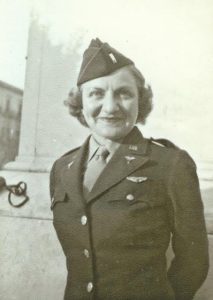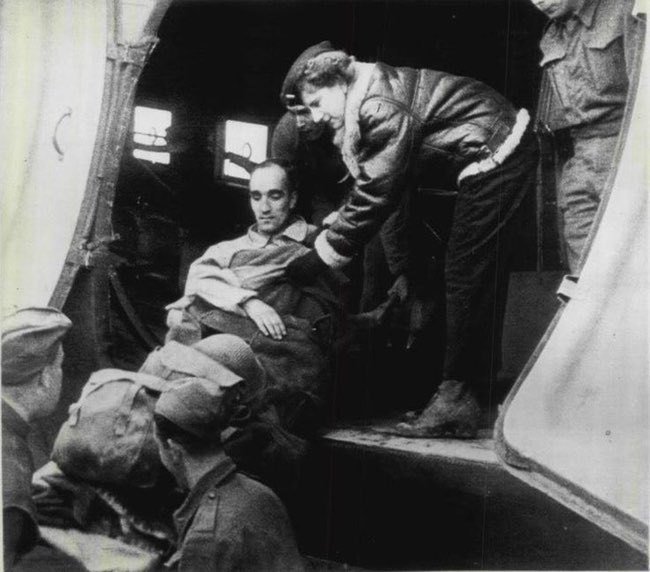Aleda E. Lutz
First Lieutenant
802d Medical Air Evacuation Squadron, 12th Air Force
November 9, 1915 – November 1, 1944

1st Lt. Aleda E. Lutz Emmalemmalee
Aleda Lutz, known as “Lutzy” by her friends, was a small-town woman with big dreams. Her desire to help others took her on a journey across the ocean to aid wounded Soldiers in World War II. Lutz’s legacy as a well-respected flight nurse inspired other women to pursue this honorable and dangerous role.
Aleda Ester Lutz was born on November 9, 1915, and grew up in Freeland, Michigan as the youngest of 10 children. She went on to be the only child in her family to graduate high school, graduating from Arthur Hill High School in 1933. She earned a degree in nursing from Saginaw General Hospital of Nursing (now Covenant HealthCare) in 1937. In 1940, at only 25, she worked as a nurse at a private practice, living in a boarding house with her sister Hulda. After the start of World War II, she realized she wanted to put her skills to good use. Three of her brothers had served in the U.S. military during both World Wars. She decided to uphold her family’s legacy of military service and enlisted in the Army Nurse Corps in February 1942.
As the child of German immigrants, Lutz grew up bilingual which was an asset to the Army. Her military career began at the Station Hospital at Selfridge Field, located in Mount Clemens, Michigan (now Selfridge Air National Guard Base); there, she served as a general duty nurse, handling around 25 patients on her own. Once she completed basic training, she volunteered for the flight nurse program; these women provided care to the sick and wounded via air evacuation missions. She took the required pilot physical test and became one of only three women to pass. Lutz was promoted to first lieutenant and joined the 802d Medical Air Evacuation Squadron (MAES) in the Army’s 12th Air Force, the first team of flight nurses to deploy overseas.
In the early days of commercial flight, stewardesses were required to be registered nurses, helping uneasy passengers who became sick during a flight. This practice evolved to utilizing trained nurses in war zones through the flight nurse program. This program had been in the works long before World War II but had been met with resistance. The Army activated the 507th Air Evacuation Squad in October 1942 and, with the 349th Air Evacuation Group, formed the Army Air Forces School of Air Evacuation in June 1943. Historian Mary Sarnecky described these trailblazing women and noted that “as volunteers, they underwent rigorous training and endured harrowing experiences.” Besides passing rigorous physical tests and enduring various training, all flight nurses adhered to several restrictions, including age and weight. They had to be between the ages of 21 and 36, weigh between 105 and 135 pounds, and measure between 62 and 72 inches in height. After they passed the pilot physical test, they underwent instruction in nursing, survival skills, chemical warfare, and detecting booby traps.
Flight nurse responsibilities included evacuating Soldiers from war zones by medical planes. These planes doubled as cargo vehicles and therefore were not marked with a red cross. This put them at increased risk of enemy fire. The women ensured the Soldiers remained medically stable throughout the flight. They also taught Soldiers best practices for transporting wounded on and off the planes. The “Flying Florence Nightingales” were the key to evacuating wounded Soldiers in a quick and efficient manner. Nurses in this program held much more autonomy than a standard nurse since flight nurses were in charge on these air evacuations. There were no doctors, so surgery was avoided, but flight nurses prioritized which injured Soldiers could survive the flight evacuation. Only 46 of the 1,176,048 patients that were evacuated by air died en route.

1st Lt. Aleda Lutz helps a wounded Soldier out of a plane. Captainorchardly
Lutz tragically died in a C-47 plane crash near St. Chamond, France, on November 1, 1944. The evacuation flight she was on had been caught in a storm and left no survivors. She became the first American woman to die in service during World War II but left a legacy in her wake. Lutz completed nearly 200 missions in six campaigns over a 20-month period and logged more flight hours than any other at the time, making her the most experienced flight nurse during her lifetime. She received numerous awards, including the Distinguished Flying Cross, Air Medal with four Oak Leaf clusters, European-Africa-Middle Eastern Campaign Medal, Red Cross Medal, and Purple Heart. Her home state of Michigan posthumously presented her with induction into the Saginaw Hall of Fame in 1979, the Michigan Women’s Hall of Fame in 1994, and the Michigan Aviation Hall of Fame in 2010. Many facilities were named after her including the Aleda E. Lutz Department of Veterans Affairs Medical Center in Saginaw, Michigan, a former troopship turned hospital ship, and a C-47.
The Flight Nurse’s Creed
I will summon every resource to prevent the triumph of death over life.
I will stand guard over the medicines and equipment entrusted to my care and ensure their proper use.
I will be untiring in the performances of my duties and I will remember that, upon my disposition and spirit, will in large measure depend the morale of my patients.
I will be faithful to my training and to the wisdom handed down to me by those who have gone before me.
I have taken a nurse’s oath, reverent in man’s mind because of the spirit and work of its creator, Florence Nightingale. She, I remember, was called the “Lady with the Lamp.”
It is now my privilege to lift this lamp of hope and faith and courage in my profession to heights not known by her in her time. Together with the help of flight surgeons and surgical technicians, I can set the very skies ablaze with life and promise for the sick, injured, and wounded who are my sacred charges.
. . . This I will do. I will not falter in war or in peace.
Carly Herrud
Graduate Historic Research Intern
Sources
Barger, Judith. Beyond the Call of Duty: Army Flight Nursing in World War II. Ashland: The Kent State University Press, 2013.
Evening star. (Washington, D.C.), 19 March 1943. Chronicling America: Historic American Newspapers. Library of Congress. https://chroniclingamerica.loc.gov/lccn/sn83045462/1943-03-19/ed-1/seq-25/.
“Flight Nurse’s Creed.” National Museum of the United States Air Force. Accessed December 1, 2022. https://www.nationalmuseum.af.mil/Visit/Museum-Exhibits/Fact-Sheets/Display/Article/196420/flight-nurses-creed/.
“Flight Nurse School.” The American Journal of Nursing 52, no. 7 (1952): 833–833. http://www.jstor.org/stable/3459721.
Helppi, Karen. “First Lieutenant Aleda E. Lutz.” Military History of the Upper Great Lakes. Published October 30, 2019. Accessed October 20, 2022.
Sarnecky, Mary T. A History of the U.S. Army Nurse Corps. Philadelphia: University of Pennsylvania Press, 1999.
“U.S. Army Nurse Aleda E. Lutz, Distinguished Flying Cross Recipient, Died in Combat Zone.” FOLD3 by Ancestry. Accessed November 16, 2022. https://www.fold3.com/memorial/529925535/aleda-e-lutz/stories.
Vogt, Tom. “Flight Nurses: Angels for WWII Wounded.” Columbian, May 27, 2007. http://proxygw.wrlc.org/login?url=https://www.proquest.com/newspapers/flight-nurses-angels-wwii-wounded/docview/253324635/se-2.
